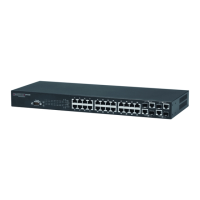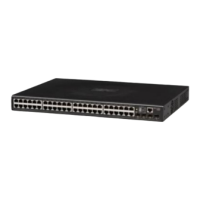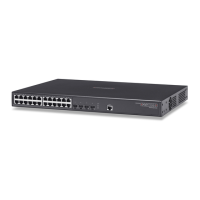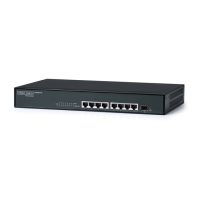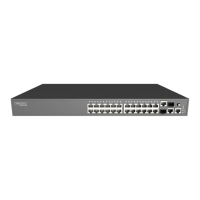C
HAPTER
34
| VLAN Commands
Configuring IEEE 802.1Q Tunneling
– 797 –
4. Set the Tag Protocol Identifier (TPID) value of the tunnel access port.
This step is required if the attached client is using a nonstandard 2-byte
ethertype to identify 802.1Q tagged frames. The standard ethertype
value is 0x8100. (See switchport dot1q-tunnel tpid.)
5. Configure the QinQ tunnel access port to join the SPVLAN as an
untagged member (switchport allowed vlan).
6. Configure the SPVLAN ID as the native VID on the QinQ tunnel access
port (switchport native vlan).
7. Configure the QinQ tunnel uplink port to dot1Q-tunnel uplink mode
(switchport dot1q-tunnel mode).
8. Configure the QinQ tunnel uplink port to join the SPVLAN as a tagged
member (switchport allowed vlan).
Limitations for QinQ
◆ The native VLAN for the tunnel uplink ports and tunnel access ports
cannot be the same. However, the same service VLANs can be set on
both tunnel port types.
◆ IGMP Snooping should not be enabled on a tunnel access port.
◆ If the spanning tree protocol is enabled, be aware that a tunnel access
or tunnel uplink port may
be disabled if the spanning tree structure is
automatically reconfigured to overcome
a break in the tree. It is
therefore advisable to disable spanning tree on these ports.
dot1q-tunnel
system-tunnel-
control
This command sets the switch to operate in QinQ mode. Use the no form
to disable QinQ operating mode.
SYNTAX
[no] dot1q-tunnel system-tunnel-control
DEFAULT SETTING
Disabled
COMMAND MODE
Global Configuration
COMMAND USAGE
QinQ tunnel mode must be enabled on the switch for QinQ interface
settings to be functional.
EXAMPLE
Console(config)#dot1q-tunnel system-tunnel-control
Console(config)#

